In the ever-evolving world of interior design, certain styles remain steadfastly appealing, and none quite capture this enduring allure like the classic combination of black and white. Whether you’re a novice just dipping your toes into the world of home decor or a seasoned enthusiast seeking fresh inspiration, the monochromatic palette offers a timeless elegance that is both striking and sophisticated. This article will guide you through 13 refreshing black and white interiors, each uniquely demonstrating how this dynamic duo can transform spaces to reflect both personal style and universal charm.
The importance of mastering black and white interiors lies in their versatility and ability to anchor any room with a sense of balance and harmony. As you explore these curated spaces, you’ll discover how to artfully blend these colors to create environments that are not only visually compelling but also inviting and functional. From dramatic contrasts to subtle nuances, you’ll learn practical techniques to infuse your home with the right amount of flair, regardless of your current design expertise.
Our journey will reveal a range of design possibilities, proving that black and white interiors are anything but monotonous. You’ll find inspiration in the simplicity of minimalistic designs, the boldness of modern aesthetics, and the timelessness of classic styles, all while gaining confidence to express your own creative vision. By the end of this article, you’ll have a toolkit of ideas and insights to effortlessly incorporate this classic theme into your home, ensuring your spaces remain stylish and fresh for years to come.
Exploring Monochrome Magic
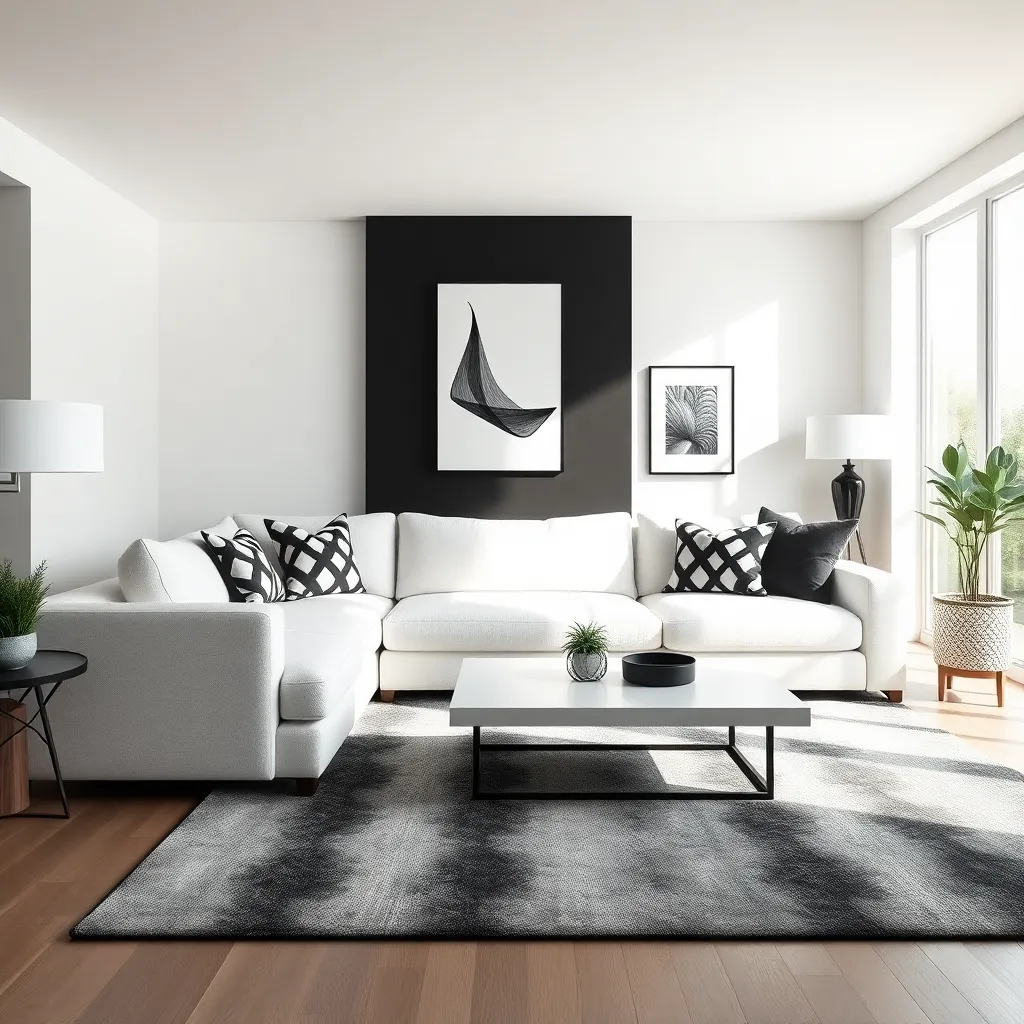
Monochrome palettes offer a timeless appeal that can transform any space with minimal effort. To create a striking monochrome interior, start by selecting a dominant base color—either black or white—and layer the opposite color through accents and furnishings for a balanced look.
Consider using a black sofa as a bold anchor piece in your living room, complemented by white throw pillows and a white area rug. This contrast not only adds visual interest but also highlights the room’s architectural features, such as window frames or molding, if painted in a sharp black hue.
For those just starting out with monochrome design, focus on incorporating texture through varied materials. Opt for textured wallpaper in a subtle pattern or a shag rug to add depth, ensuring the room doesn’t feel flat or sterile.
Advanced decorators can experiment with different finishes to enhance the monochrome effect. Incorporating glossy materials like a high-shine lacquered coffee table can add light and dimension, while matte finishes on walls or cabinetry offer a sophisticated, understated elegance.
Incorporating Bold Patterns
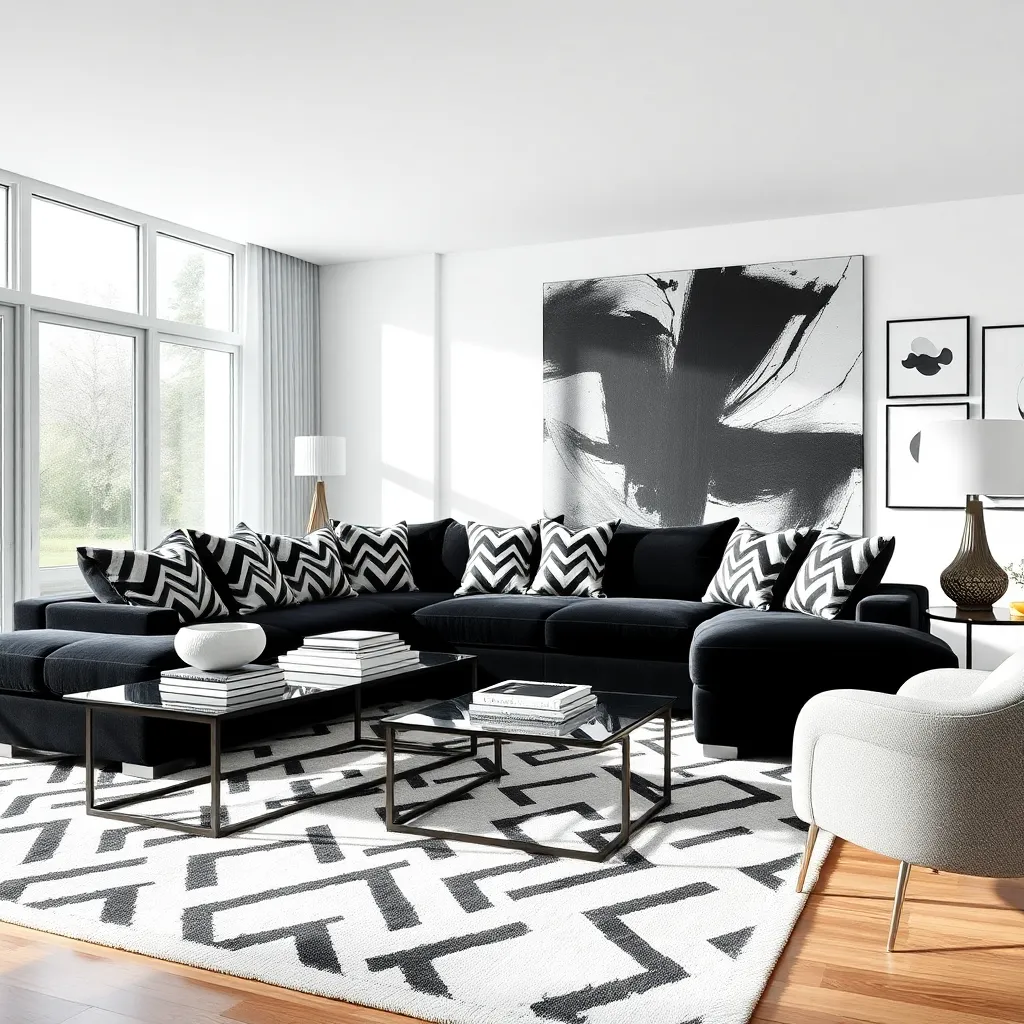
Diving into bold patterns can instantly invigorate a black and white interior, adding depth and character. Start by introducing a striking patterned rug as the focal point, which can ground the room and provide a visual anchor.
Mixing patterns is a skillful way to enhance your monochrome palette without overwhelming the space. Choose patterns in different scales—large geometric prints paired with smaller houndstooth or polka dot motifs can create a balanced yet dynamic look.
For a more advanced touch, consider incorporating patterned wallpapers. A feature wall with a bold black and white botanical or abstract design can serve as an artful statement without needing additional decor.
Accessorizing with patterned textiles, like cushions or throws, is an easy way to experiment with bold designs. Opt for textiles with black and white stripes or checks to add texture and interest, providing a cohesive look that complements your existing decor.
Playing with Light and Shadow
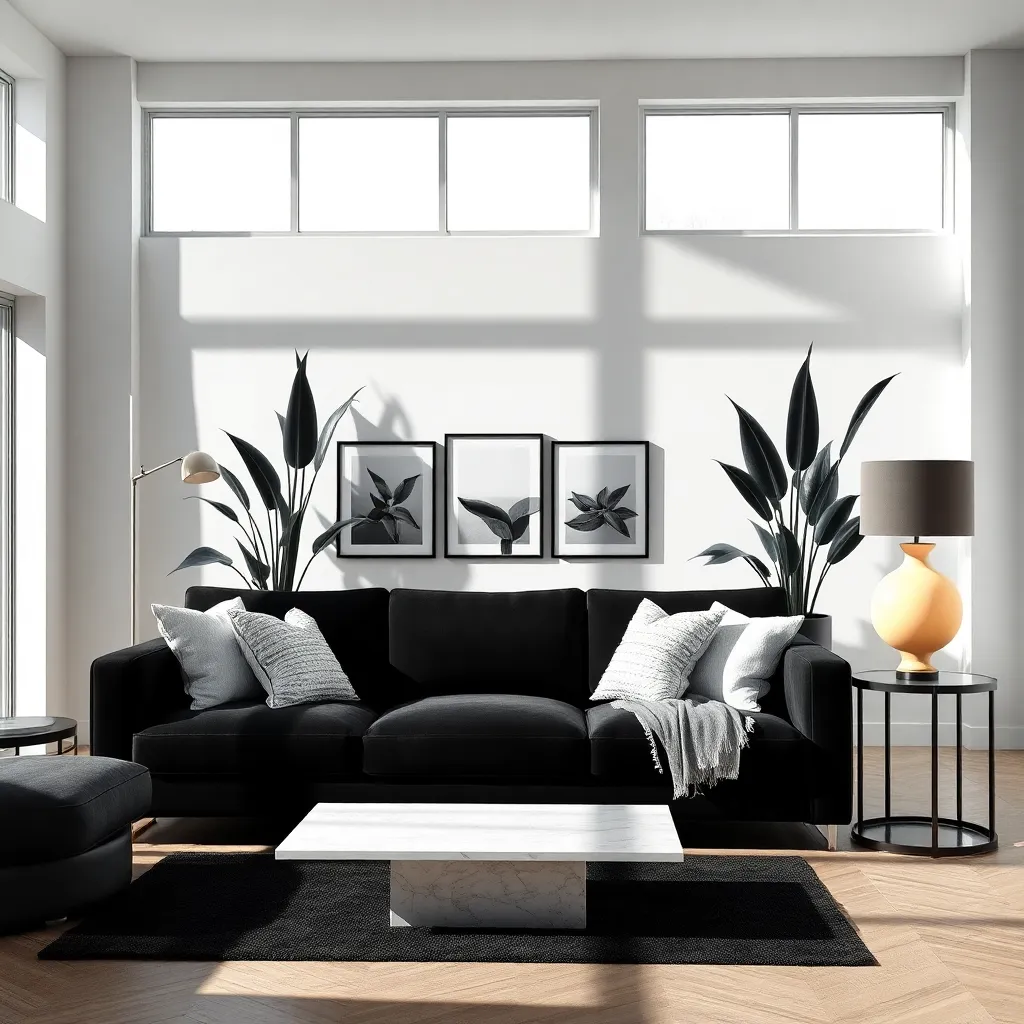
Exploring the interaction of light and shadow in a black and white interior can dramatically influence the space’s ambiance. Start by positioning furniture strategically to allow natural light to highlight key elements, such as a striking monochrome artwork or a sculptural piece.
Consider introducing different light sources to create depth and interest. A combination of overhead lighting, floor lamps, and wall sconces can produce varied layers of light and shadow, enhancing the dynamic contrast inherent in black and white decor.
For beginners, start with simple techniques like using sheer curtains to diffuse natural light softly. Advanced decorators might experiment with reflective surfaces such as glass or polished stone to amplify light, creating a sense of openness and sophistication.
Incorporate materials that play up contrast, like pairing matte black finishes with glossy white surfaces. This technique not only accentuates the interplay of light and shadow but also adds a tactile dimension that invites interaction and engagement in your space.
Choosing Timeless Furniture Styles
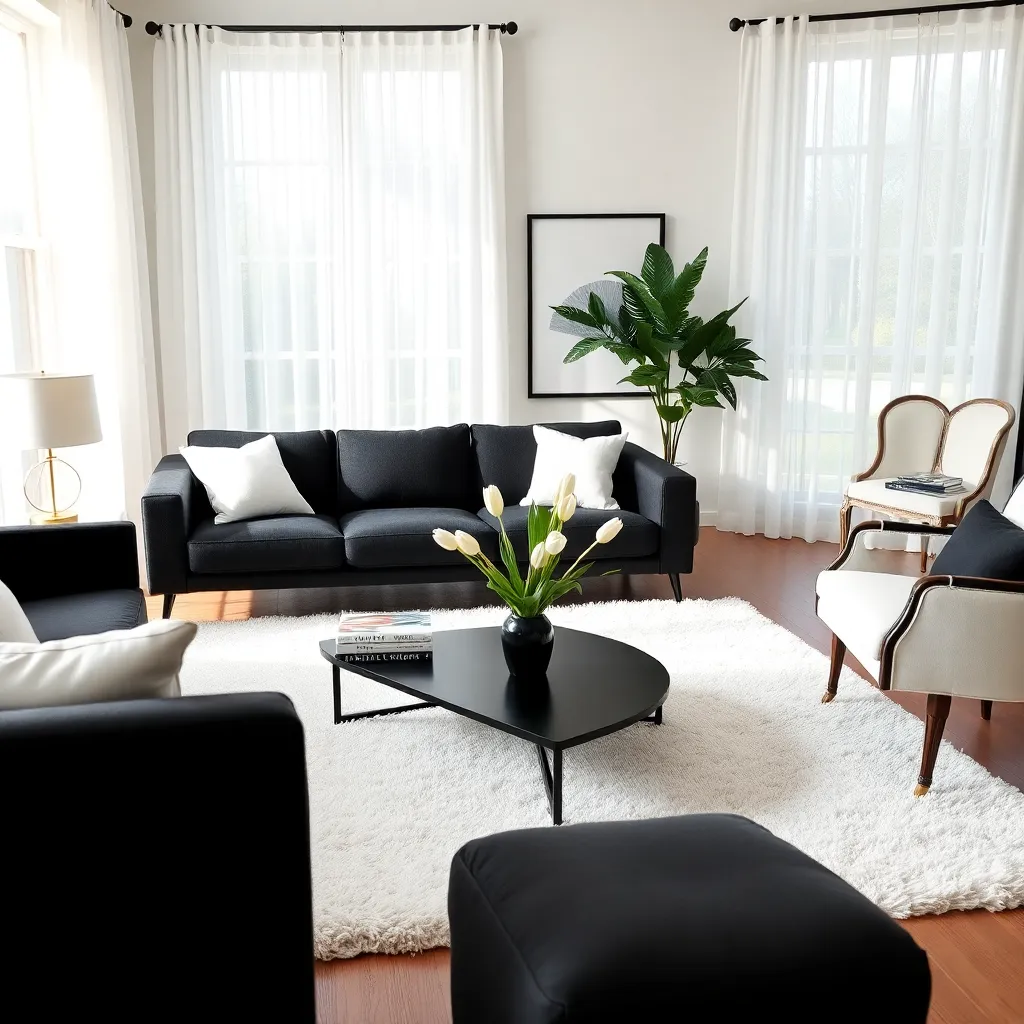
When selecting timeless furniture styles for your black and white interiors, consider pieces that have stood the test of time, such as the classic Chesterfield sofa or an elegant Eames lounge chair. These items bring a sense of history and refinement to your space while seamlessly blending with contemporary elements.
Opt for furniture with clean lines and neutral tones, as these characteristics ensure longevity in design. A well-chosen piece in natural materials like leather or wood can serve as a versatile anchor in your room, allowing you to experiment with other decor elements around it.
Incorporate versatile furniture pieces that can adapt to different settings within your home. For example, a mid-century modern sideboard can function as a storage unit in the dining room or as a stylish media console in the living room.
Balance is key when integrating timeless furniture into your interior. Aim for a mix of vintage and modern pieces to create a dynamic yet harmonious environment, such as pairing a sleek black steel coffee table with a plush white sofa.
Accessorizing with Modern Elegance
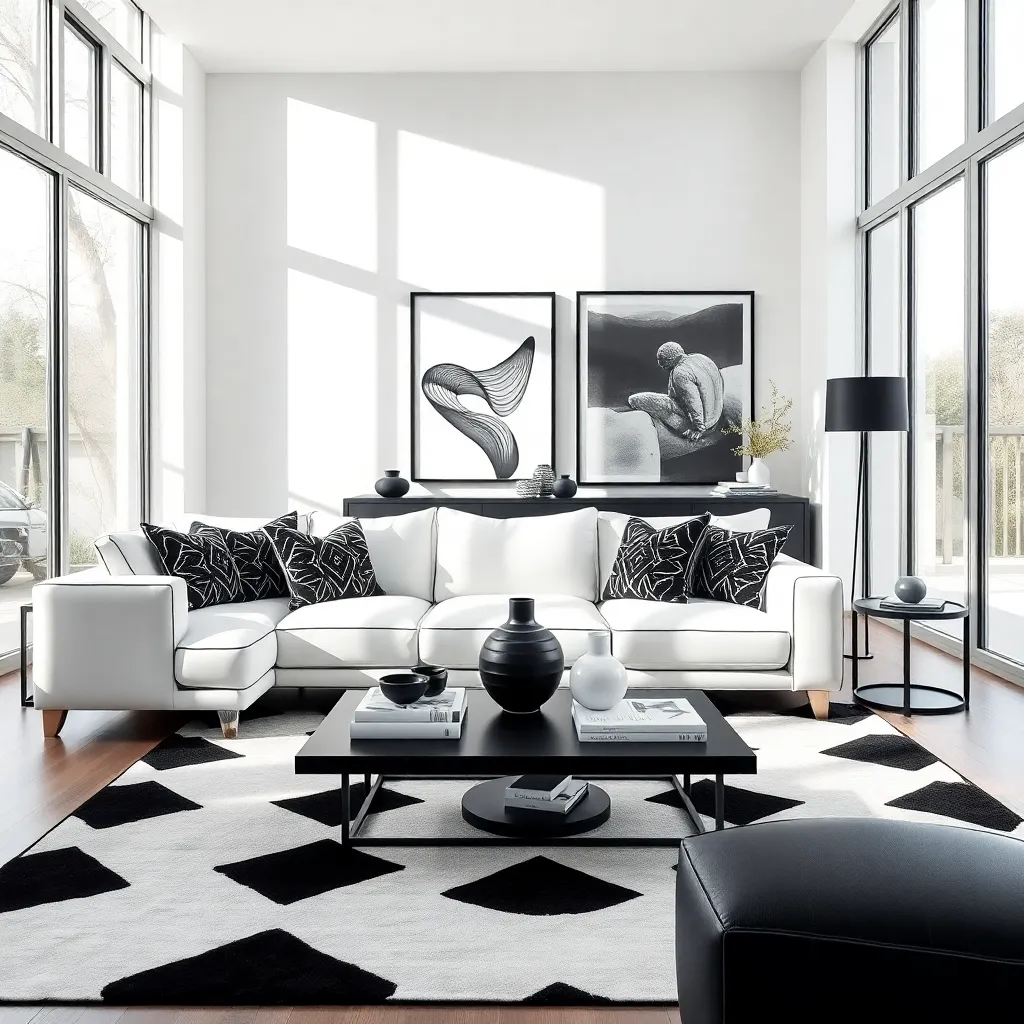
Accessorizing a black and white interior with modern elegance requires a keen eye for detail and a minimalist approach. Start by incorporating sleek metallic accents, such as chrome or brushed nickel, which add a sophisticated edge without overwhelming the space.
Consider using geometric patterns in your accessories to echo the clean lines often found in modern design. Throw pillows or area rugs with subtle black and white geometric designs can create visual interest and reinforce the room’s sleek aesthetic.
Lighting plays a crucial role in modern elegance, so opt for statement light fixtures like a sculptural pendant or an angular floor lamp. Position these elements strategically to enhance focal points in your room, whether over a dining table or in a cozy reading nook.
For those looking to add a layer of sophistication, introduce textured fabrics in monochrome tones—think silk, velvet, or leather. These materials not only provide a tactile experience but also contribute to the luxurious feel of the space.
Plants can also be an elegant addition, offering both life and color contrast to a monochrome palette. Choose plants with architectural forms such as succulents or fiddle leaf figs, and place them in sleek black or white pots to maintain the modern theme.
Balancing Minimalism and Drama
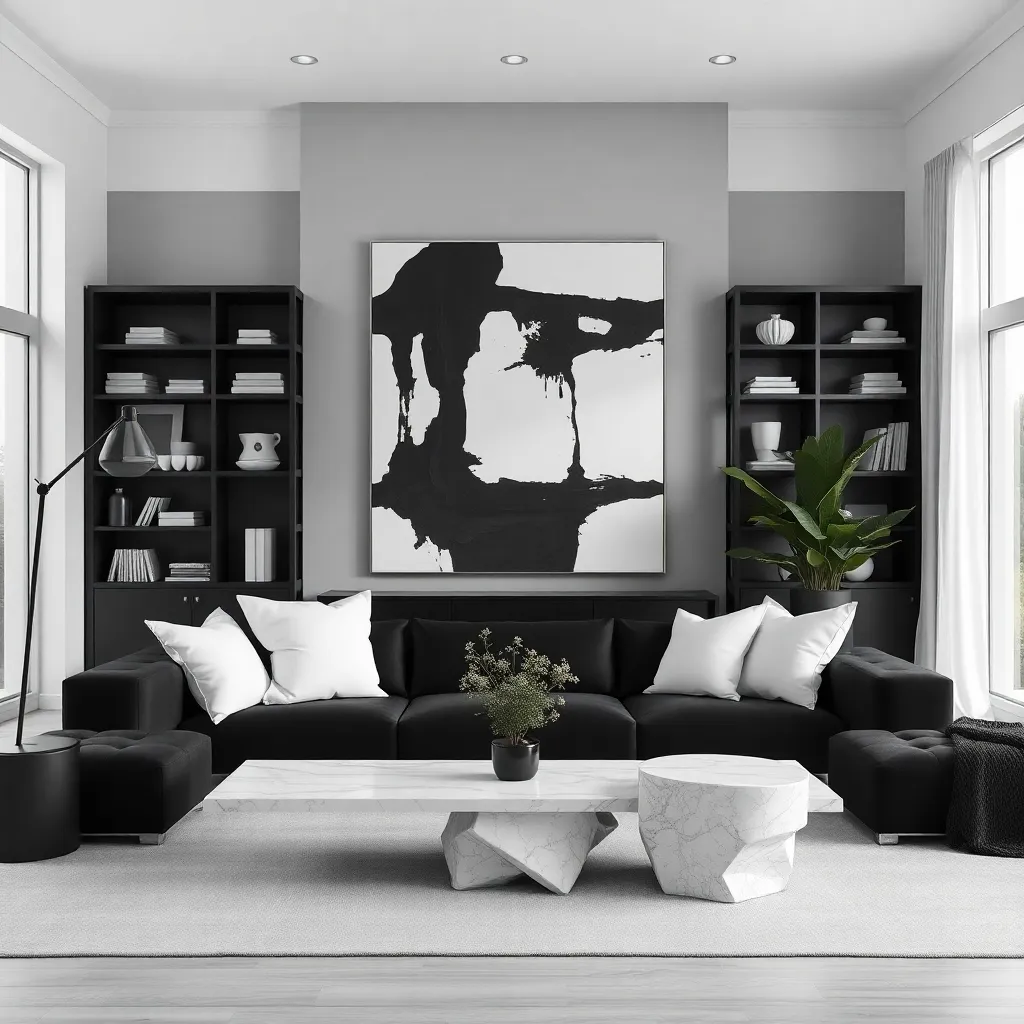
Balancing minimalism with drama in a black and white interior requires a delicate touch, yet it can transform a space into a timeless masterpiece. Start by selecting a dominant color—either black or white—for the larger elements like walls or sofas, and use the opposite color to add contrast with smaller pieces like cushions or artwork.
Incorporate furniture with clean lines to maintain a minimalist aesthetic while introducing dramatic elements through bold shapes or intricate textures. For instance, a sleek black leather sofa can be accented with a plush, patterned white throw or an oversized, monochromatic art piece to create visual interest.
Consider the use of high-gloss finishes to add a touch of elegance and sophistication, which can enhance both minimalist and dramatic elements. A black lacquered coffee table, for example, can become a focal point in a room, reflecting light and adding depth without overwhelming the space.
Layer different materials to strike a balance between simplicity and excitement. Pairing smooth surfaces like marble with rougher textures, such as a shaggy rug, can create a dynamic yet cohesive look that keeps the eye engaged while staying true to a minimalist ethos.
The Impact of Contrasting Textures
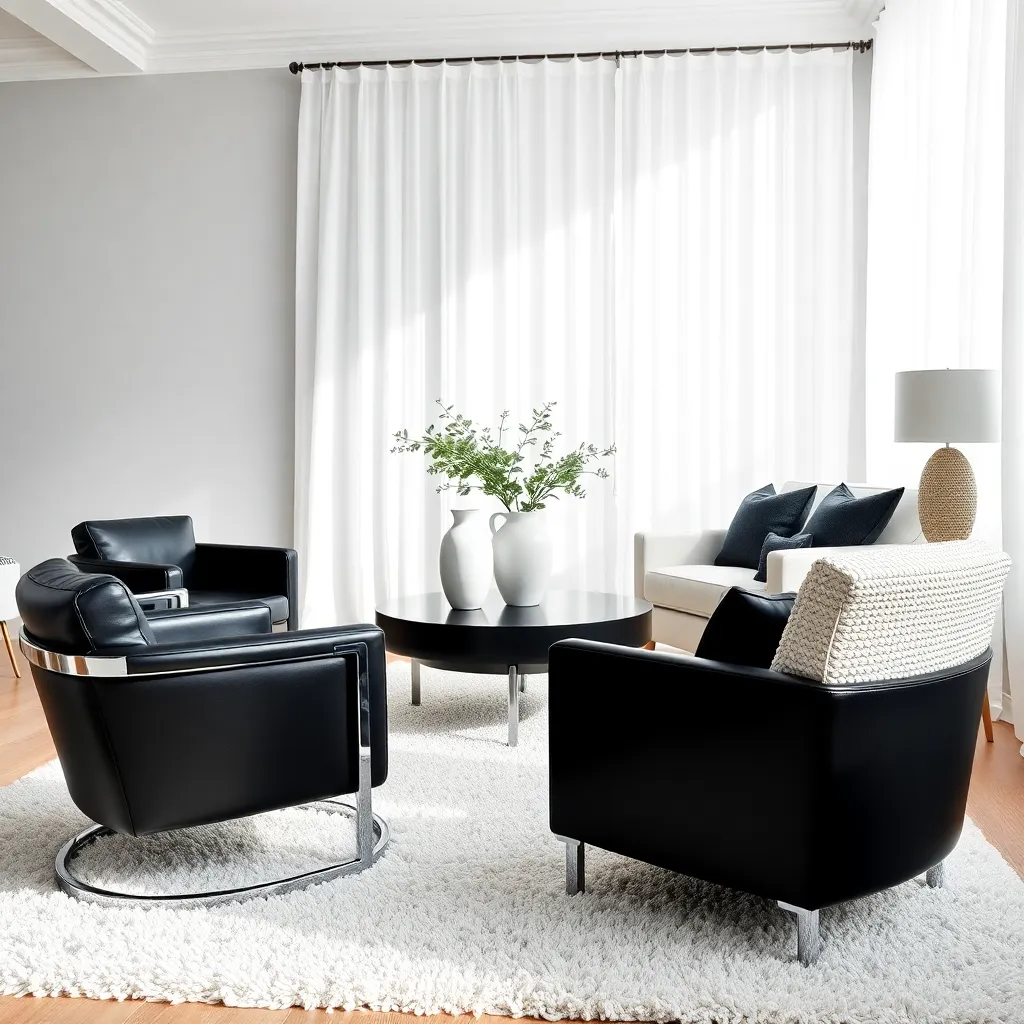
Incorporating contrasting textures in a black and white interior can elevate the space by adding depth and interest. Beginners can start by mixing materials like a smooth leather sofa with a chunky knit throw to create a tactile experience that draws attention.
To achieve a sophisticated look, consider using a combination of glossy and matte finishes throughout the room. This approach not only enhances visual intrigue but also allows light to interact differently with each surface, creating a dynamic environment.
Advanced decorators might integrate materials like marble and wood for a luxurious yet grounded feel. Strategically place a marble-topped coffee table against a dark wooden floor to highlight the contrast, making each element stand out.
For a minimalist approach, focus on subtle texture variations within the same color palette. Opt for a black velvet armchair paired with a white boucle rug to maintain a monochrome aesthetic while introducing a sense of warmth and comfort.
Highlighting Architectural Features
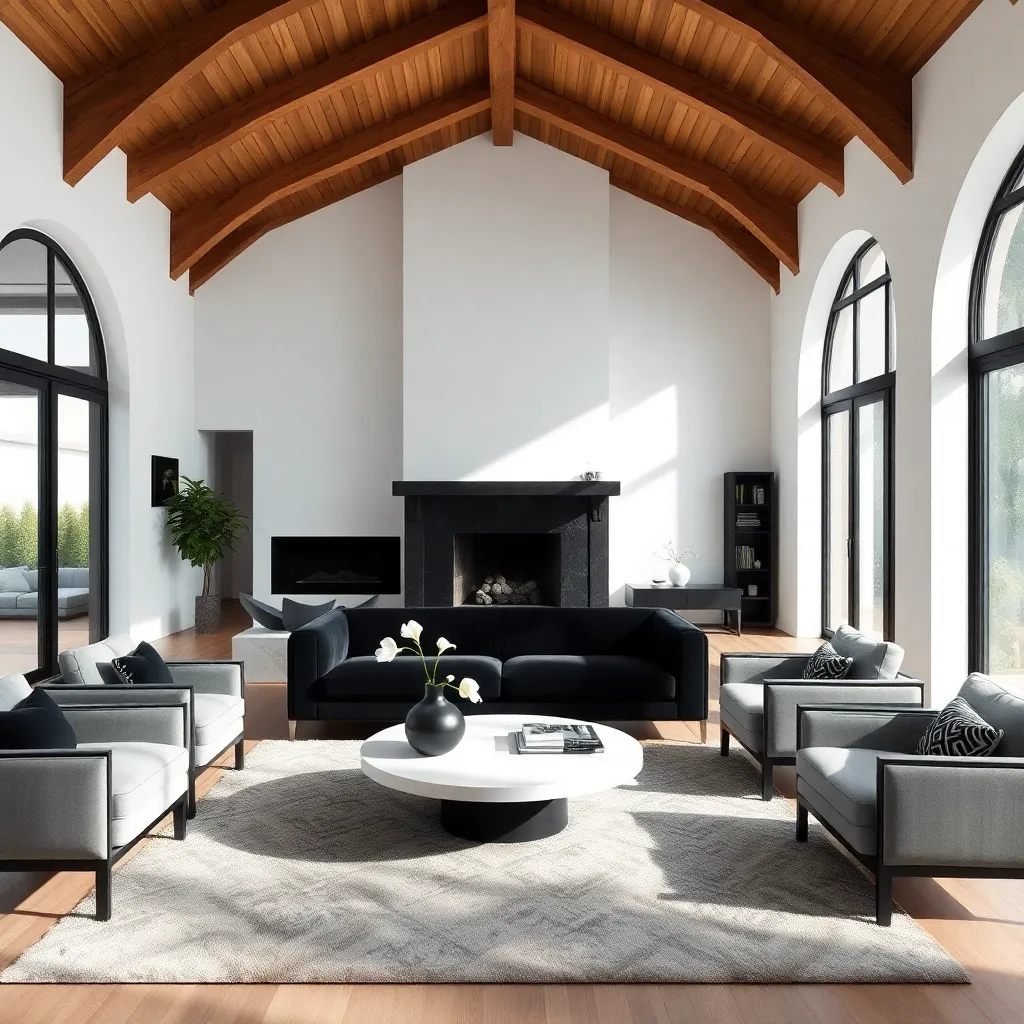
Incorporating black and white color schemes can accentuate architectural features by providing a stark contrast that draws the eye. To highlight intricate moldings or a grand staircase, use a rich black hue on the details against a soft white backdrop, allowing these features to stand out prominently.
Consider how lighting can enhance these architectural elements by creating shadows and depth. Installing strategically placed spotlights or under-cabinet lighting can emphasize textures and create a dramatic effect, especially in spaces with high ceilings or unique structures.
For beginners, a simple way to highlight an architectural detail is by framing it with a bold black trim or border. This technique is particularly effective around windows or doorways, offering a crisp delineation that can make these features a focal point in any room.
Advanced decorators might experiment with varying finishes, such as pairing matte black paint on beams with glossy white on ceilings, to add visual interest and sophistication. This not only highlights the features but also adds a layer of complexity to the room’s overall design.
Integrating Natural Elements
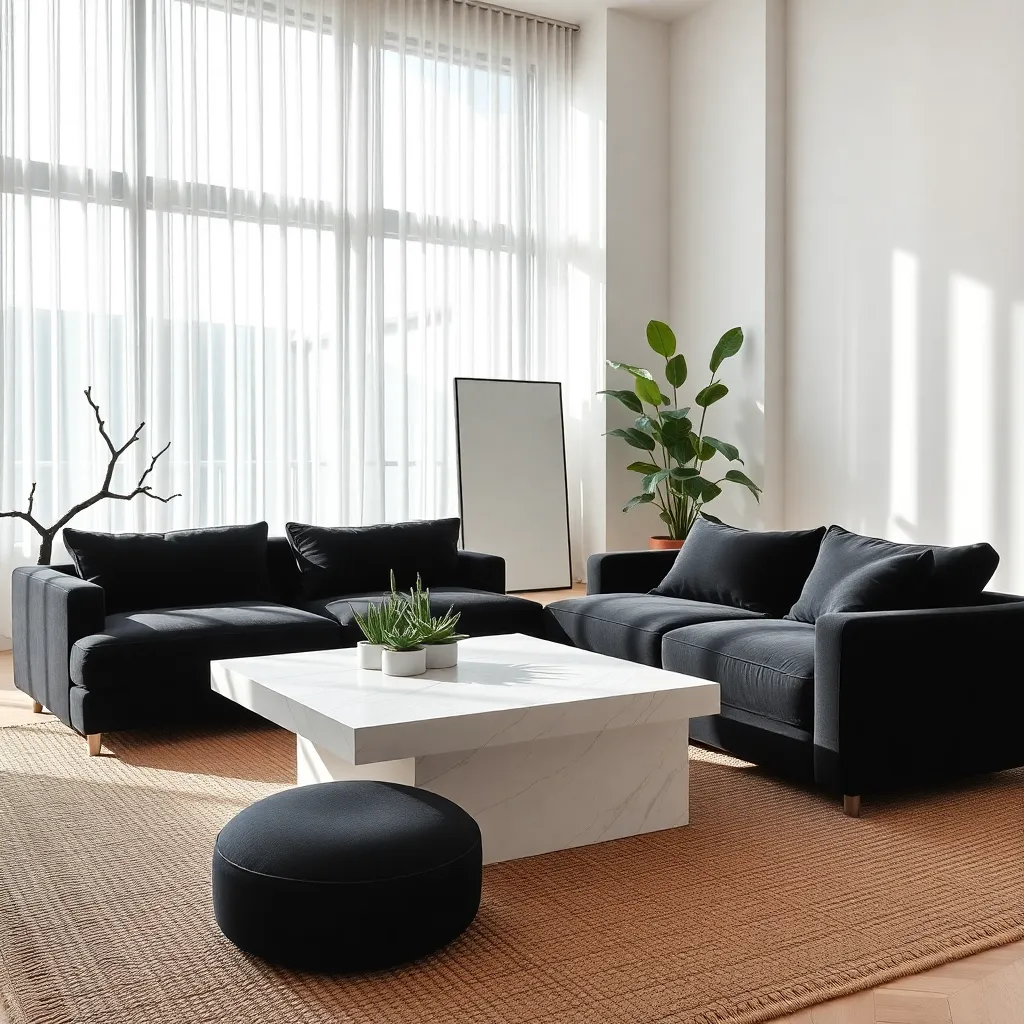
Incorporating natural elements into black and white interiors can create a serene and timeless atmosphere. Begin by selecting furniture pieces made from natural materials such as wood, rattan, or stone to add warmth and texture to the space.
Consider using plants as a way to introduce color and life into your design. Opt for low-maintenance greenery like succulents or ferns that can thrive in various lighting conditions, making them perfect for any room.
For a more advanced touch, use natural textiles such as cotton or linen in cushions, drapes, and rugs. These materials not only add comfort but also provide a subtle contrast against the stark black and white color scheme, enriching the overall aesthetic.
To further integrate nature, consider using artwork or accessories that reflect natural motifs. Look for pieces that feature botanical prints, landscapes, or earthy tones to complement your design while maintaining the elegant simplicity of your black and white palette.
Creating Focal Points Strategically
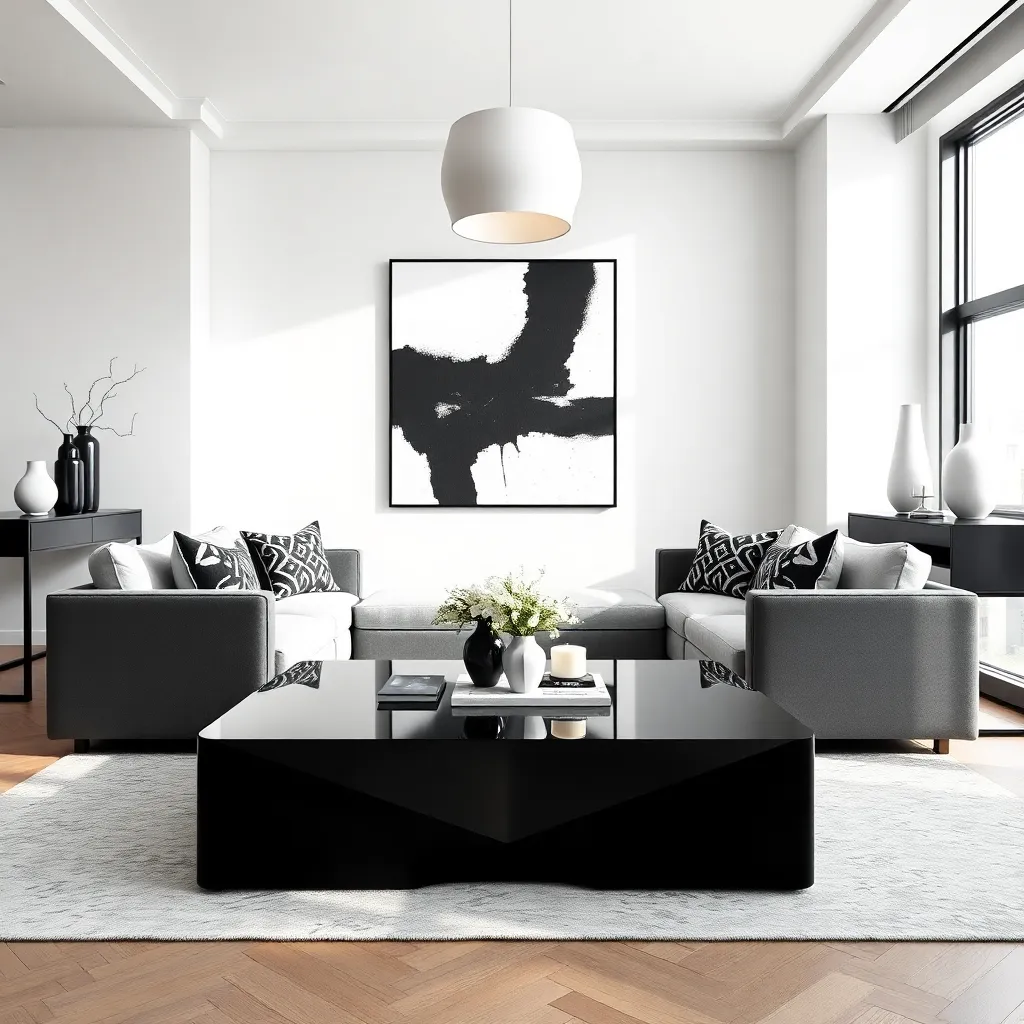
In any black and white interior, creating a focal point is essential for adding visual interest and guiding the eye seamlessly through the space. Start by selecting a standout piece, such as a large artwork or a bold piece of furniture, that contrasts yet complements the monochromatic palette.
Placing the focal piece strategically can transform the room’s dynamics. Position it on a wall devoid of other distractions to allow it to truly shine, ensuring it’s neither overshadowed nor competing with other elements.
For those new to interior design, consider using a striking black or white rug to ground the room and draw attention to the center. Advanced decorators might layer textures—such as a glossy black table amidst matte white surroundings—to create depth and dimension.
Floral arrangements or sculptures can act as focal points with a softer touch. Choose pieces with unique shapes or colors that pop against the black and white background, making sure they are proportionate to the room’s scale.
Maximizing Space with Dual Tones
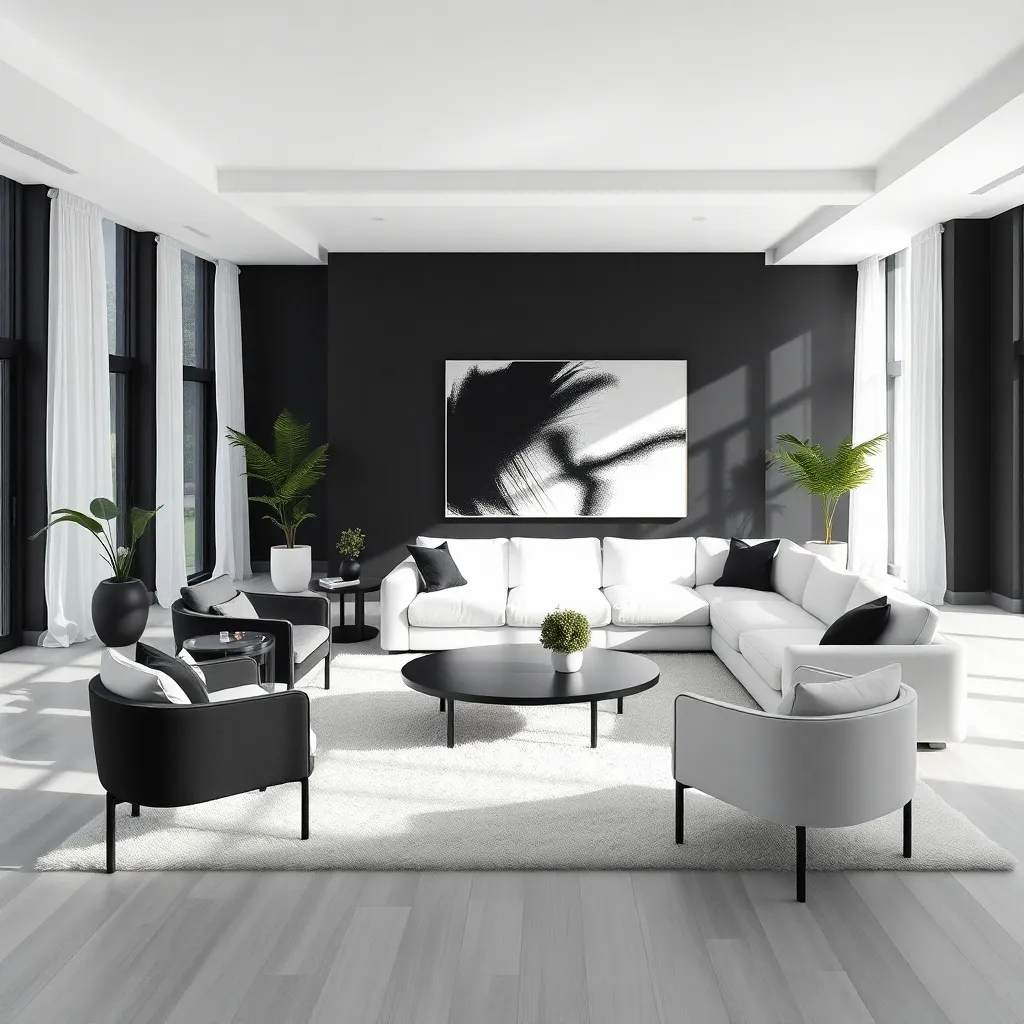
Incorporating dual tones is a clever way to maximize space in your home, especially when using a classic black and white palette. Begin by choosing a dominant color—often white in smaller spaces—to create an airy, open atmosphere, allowing black to serve as a grounding accent.
Consider furniture that complements this dual-tone approach, such as a white sofa with black legs or a black coffee table with a white top. Arranging these pieces thoughtfully can create a balanced aesthetic, drawing attention to specific areas without overwhelming the room.
For those looking to add depth, integrate textures and finishes that play with light and shadow. Glossy black surfaces and matte white walls can create a dynamic interplay, enhancing the perception of space through reflection and absorption.
Advanced decorators might experiment with transitional elements like rugs or throws that blend the two tones. Opt for patterns that subtly incorporate both colors, such as a geometric or herringbone design, to tie the room together and prevent a stark divide between the tones.
Curating Art for Black and White
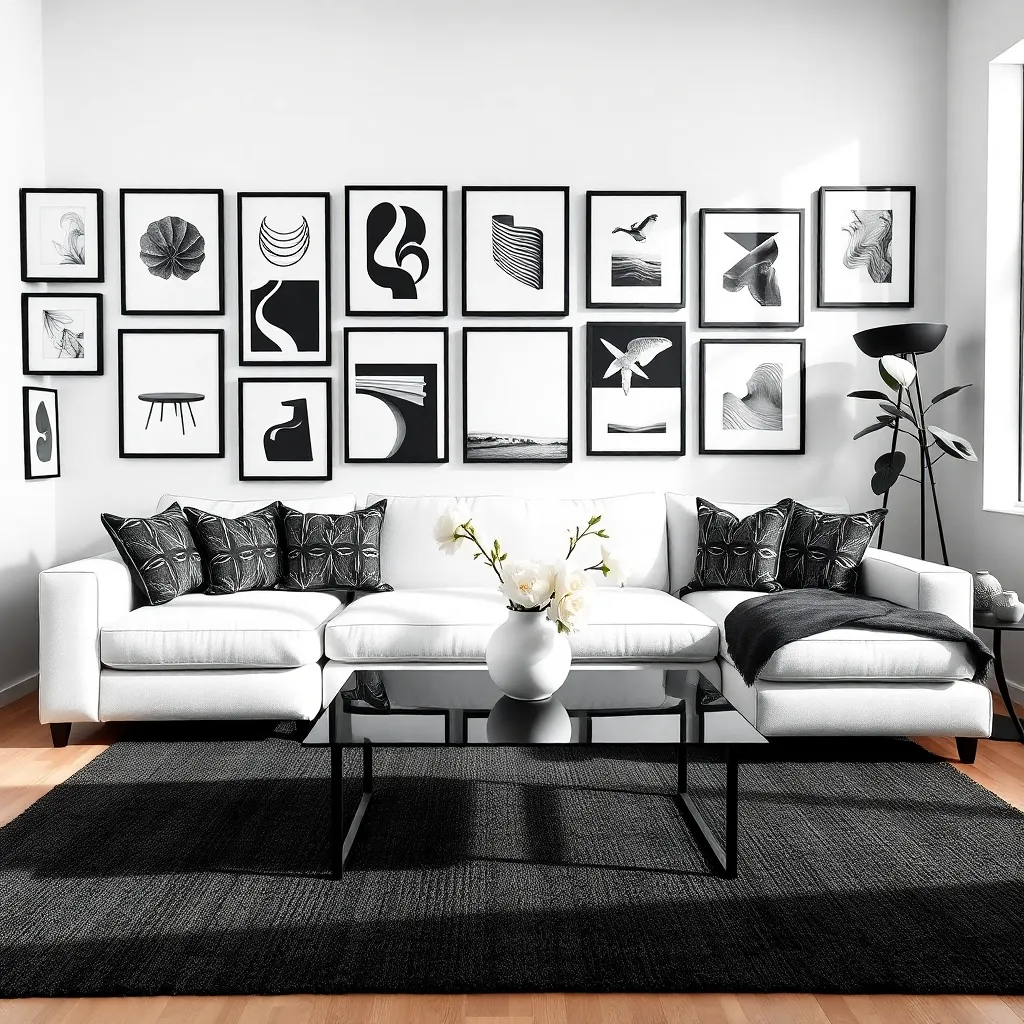
Curating art for a black and white interior requires a balance between subtlety and impact. Begin by selecting art pieces that either contrast with the monochrome palette or seamlessly blend in, such as bold black frames for white walls or minimalistic white frames for black walls.
Consider the scale of the artwork in relation to your space to maintain proportion. Large, dramatic pieces can serve as focal points, while smaller, collaged arrangements create visual interest without overwhelming the room.
To enhance the depth of a black and white scheme, incorporate art with textured elements like charcoal sketches or black-and-white photography. These choices add layers and dimensions, subtly enriching the visual narrative of the space.
For a curated and cohesive look, consider a theme or style that resonates with the overall aesthetic of your home. Whether you prefer abstract expressionism or classic black-and-white portraits, ensure your art selections reflect your personal taste while complementing the existing design elements.
Sustaining a Cohesive Design Narrative
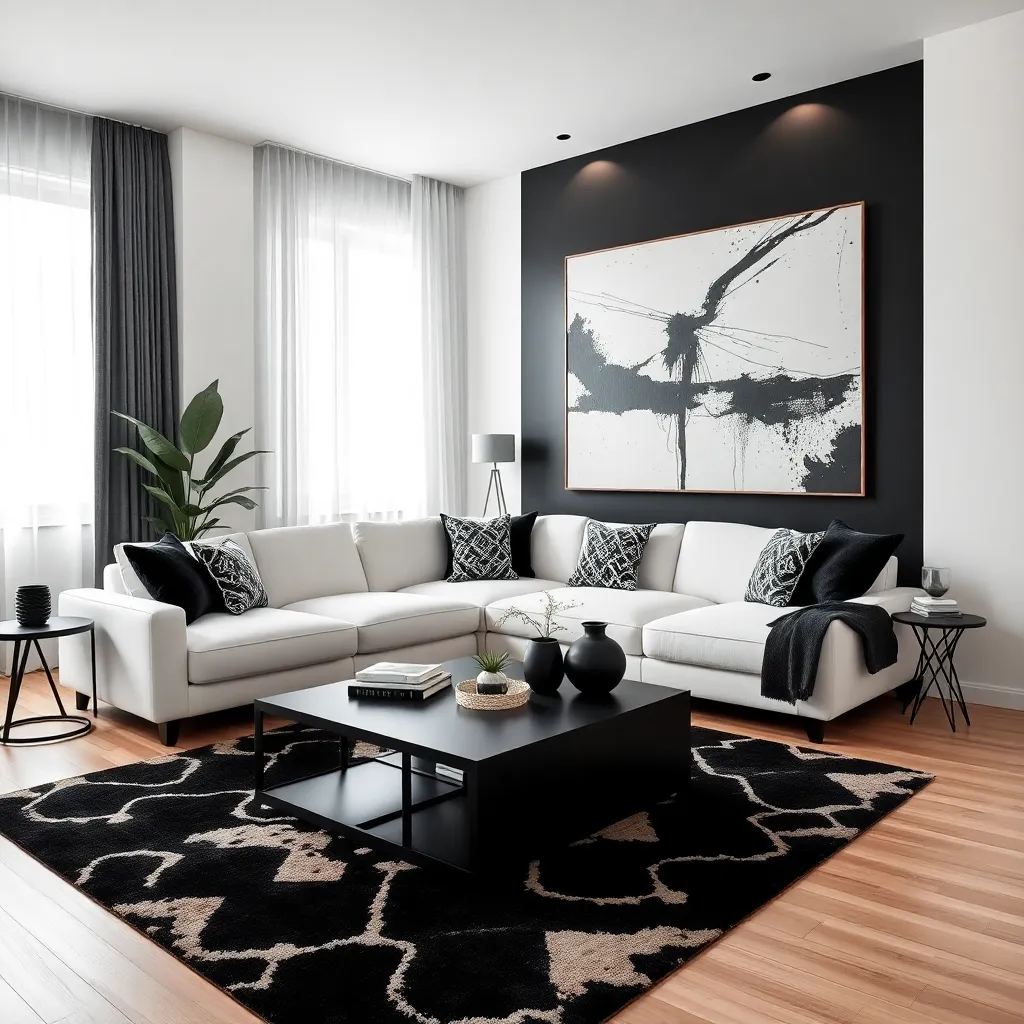
To sustain a cohesive design narrative in black and white interiors, focus on consistency in color tones and material choices throughout the space. Start by selecting a dominant color—either black or white—then use the other as an accent to create a harmonious balance.
Incorporating different textures can add depth and interest without straying from the monochromatic theme. Consider materials like a plush white rug paired with sleek black leather furniture to introduce variety while maintaining color consistency.
Furniture selection should reflect the overarching design story; for instance, opt for pieces with clean lines and minimalist appeal to enhance the timeless nature of a black and white palette. A classic black sofa can be complemented with white cushions for contrast, ensuring each element supports the overall narrative.
Advanced decorators can experiment with subtle patterns to enrich the design without overwhelming the space. Using geometric prints in cushions or artworks can add a layer of sophistication, offering visual intrigue while keeping the color scheme intact.
Conclusion: Growing Success with These Plants
As we explored the ’13 Refreshing Timeless Black And White Interiors,’ we uncovered key relationship concepts that mirror the elegance and balance found in these classic designs. From the importance of communication to embracing vulnerability, maintaining individuality, fostering trust, cherishing shared values, and nurturing intimacy, each concept is a brushstroke in the masterpiece of a thriving partnership. We also discussed the balance of giving and receiving, the power of forgiveness, the role of humor, and the necessity of growth and adaptability.
Now is the time to take action. Begin by selecting one concept that resonates most with your current relationship dynamic and commit to nurturing it this week. Whether it’s expressing appreciation more often or setting aside quality time, small steps can lead to significant improvements.
Remember to bookmark this article to revisit these timeless principles whenever you need a relationship refresher. As you continue to invest in these key areas, you’ll find that relationship success is not just a goal but an ongoing journey, rich with opportunities for deeper connection and joy. Embrace this journey with confidence, knowing you have the tools to cultivate lasting love.
